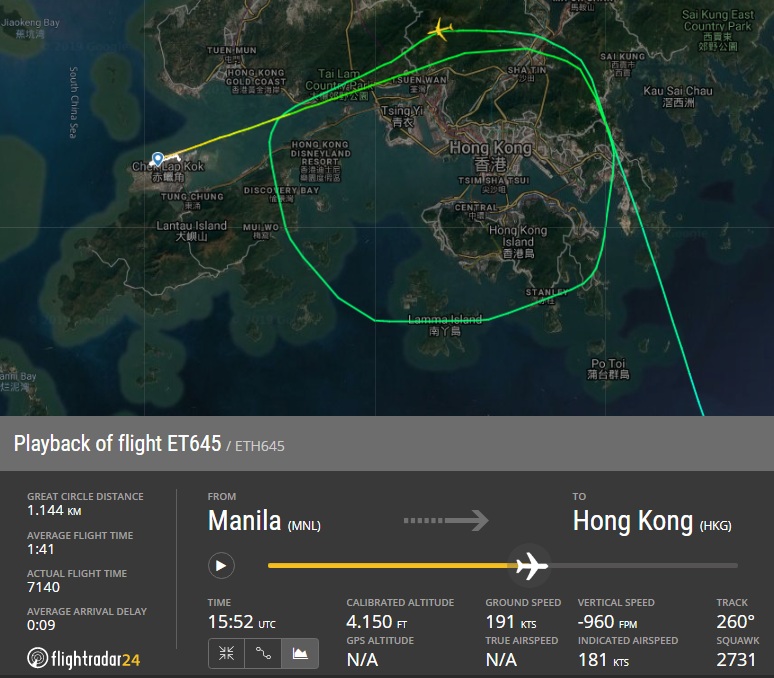
This information is added by users of ASN. Neither ASN nor the Flight Safety Foundation are responsible for the completeness or correctness of this information.
If you feel this information is incomplete or incorrect, you can submit corrected information.
| Date: | Thursday 18 July 2019 |
| Time: | 23:52 LT |
| Type: |  Boeing 787-8 Dreamliner |
| Owner/operator: | Ethiopian Airlines |
| Registration: | ET-ASG |
| MSN: | 36111/258 |
| Year of manufacture: | 2015 |
| Fatalities: | Fatalities: 0 / Occupants: 235 |
| Other fatalities: | 0 |
| Aircraft damage: | None |
| Category: | Serious incident |
| Location: | Waypoint RIVER, abeam Tai Mo Shan -
 Hong Kong Hong Kong
|
| Phase: | Approach |
| Nature: | Passenger - Scheduled |
| Departure airport: | Manila-Ninoy Aquino International Airport (MNL/RPLL) |
| Hong Kong-Chek Lap Kok International Airport (HKG/VHHH) | |
| Investigating agency: | AAIA |
| Confidence Rating: |
Ethiopian Airlines flight ET645, a Boeing 787-8, was conducting an Instrument Landing System (ILS) approach to Hong Kong International Airport when it deviated from the localiser course.
The aircraft was cleared for the runway 25R ILS approach. Shortly after passing waypoint RIVER, the aircraft kept diverging to approximately 1NM north from the approach track and descending to a lowest altitude of 3,700 ft AMSL, where the horizontal clearance between the aircraft and a spot height of 3,277 ft was 570 m.
Air Traffic Control warned the pilots and instructed the aircraft to climb to 4,500 ft AMSL.
The aircraft was repositioned for another ILS approach and landed uneventfully. There was no damage to the aircraft.
The investigation team found that this serious incident was caused by a software problem embedded in the flight control module (FCM) of the autoflight director system (AFDS).
The Boeing 787 Autoflight Function (AFF) contains a Consistent Localizer Capture (CLC) control law that reduces the risk of Localizer (LOC) course overshoot in autopilot-engaged approaches that requires a large turn (40 degrees) onto the LOC course.
CLC provides the Boeing 787 with ILS performance consistent with a Ground-Based Augmentation System (GBAS) Landing System (GLS) approach. Using Global Positioning System (GPS) and runway information from the flight management function. CLC will turn the aircraft towards the LOC course before the LOC is within parameters for capture. In order to maximize the chance of capturing the LOC in one turn. “LOC” will annunciate on the FMA when a CLC turn begins and remain annunicated through the transition to LOC capture. Normally, CLC will automatically transition to the LOC capture control law when the LOC is within parameters to capture and “LOC” will continue to be visible on the FMA.
However, depending on the geometry and groundspeed of the approach, CLC may activate for such a short time that the three FCMs fail to synchronize the engaged autopilot mode and fail to transition to the LOC capture mode. This may result in the aircraft turning to a LOC intercept angle of approximately 20 degrees and flying through the LOC on this track, rather than properly capturing the LOC.
“LOC” will remain on the FMA despite the failed capture and, in some circumstances, the aircraft may begin descent down the glideslope while 20 degrees off of the LOC course.
Cause
The LOC course deviation was caused by the software failure of the CLC auto-flight function in the AFDS.
Accident investigation:
 |
|
Sources:
https://www.thb.gov.hk/aaia/doc/ETH%20645%20Preliminary%20Serious%20Incident%20Report_final_20191206.pdf
Location
Images:

Revision history:
| Date/time | Contributor | Updates |
|---|---|---|
| 09-Dec-2019 19:41 | harro | Added |
| 21-Jul-2023 11:49 | harro | Updated |
| 19-Aug-2023 07:54 | harro | Updated |
Corrections or additions? ... Edit this accident description
The Aviation Safety Network is an exclusive service provided by:


 ©2024 Flight Safety Foundation
©2024 Flight Safety Foundation